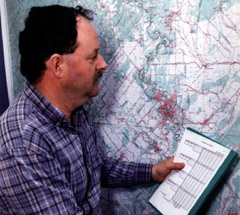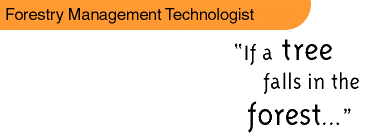 |
Serge's job
as a Forestry Management Technologist with Quebec's Ministry of
Natural Resources is definitely not routine or monotonous. Part
of it involves working with a regional forestry management agency
in the Lanaudiere region of Quebec, sitting on committees, keeping
a registry of recognized forestry producers in the area, and checking
the silviculture work the agency oversees to replenish the forests.
Producers can be individuals, municipalities, co-owners of a property,
or a large company like Domtar. Producers send Serge documents showing
the forestry work that has been done on their behalf and then he
visits the site to verify that it has been properly carried out.
The agency marks off the area using ribbons, much the same way police
forces do at crime scenes, and Serge uses the Global Positioning
System (GPS) to measure its dimensions. In the case of treeplanting
operations, he won't inspect every single tree that has been planted.
Rather, he marks off a sample area of land and checks to see how
many trees have been planted, the depth and spacing between them,
and whether they were planted in an upright position. "The tree
can't be leaning more than 30 degrees because it won't grow properly,"
he says.
He
also verifies that the soil around the tree is well packed in
and that the roots are in mineral soil to ensure proper growth.
There should be about 2,500 trees per hectare, but Serge knows
the figure won't be exact. "That's the ideal but we know that
during the treeplanting operation you don't wander around measuring
everything," he says. So he generally allows for plus or minus
10 percent.
Then
it's back to the office to prepare a report assessing the quality
of the work, and to ensure that the requested work was carried
out and meets the technical demands of the forestry agency.
Serge
also handles requests for permits from people who want to set
up maple sugar operations. They provide him with a plan that stipulates
how many trees they want to tap, how much sap they plan to collect,
whether they will be taking any wood off the property where the
maple operations are to be located, and whether they are building
a sugar shack and/or an access road to the property. "We have
to ensure that the land is managed properly," Serge explains.
He is also
responsible for issuing permits to people who want to harvest
wood from the forest. "They have to tell us the quantity of wood
they're processing and what they plan to do with it," Serge says.
A permit is then issued for a fee that is based on the amount
of wood being cut down.
|
 |


